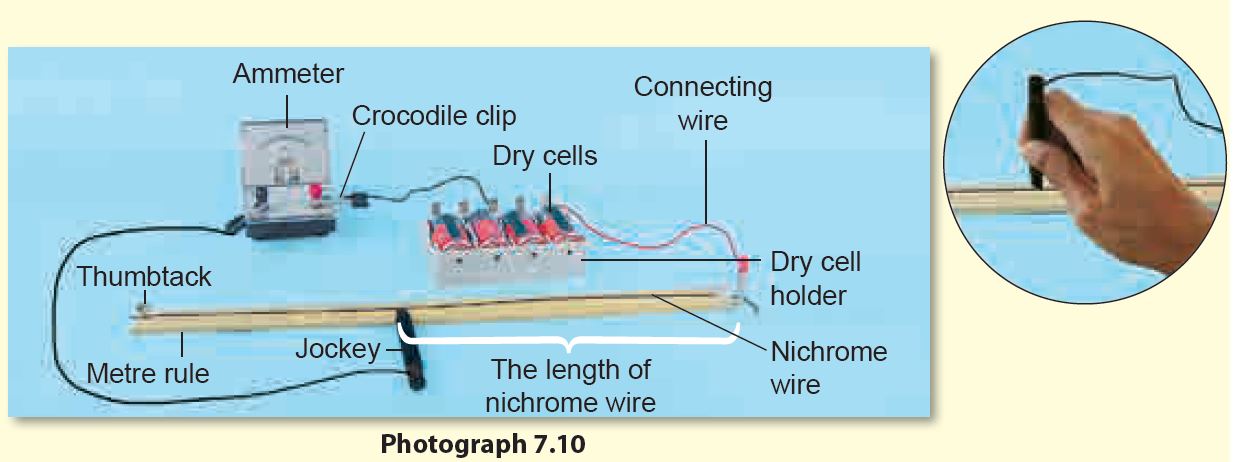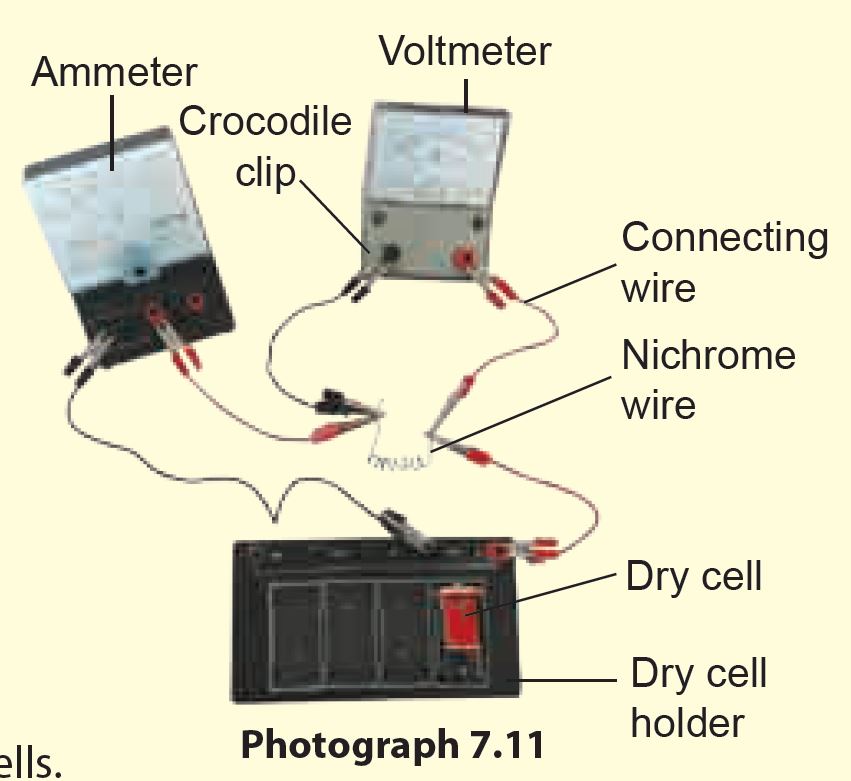Experiment 7.1:
Aim: To study the effects of changes in resistance and voltage on electric current.
(A) The effect of changes in resistance on electric current
Problem statement: What is the effect of changes in resistance on electric current?
Hypothesis: The higher the resistance, the smaller the current flow.
Variables:
(a) Constant variable: Number of dry cells
(b) Manipulated variable: The length of the nichrome wire
(c) Responding variable: Reading of the ammeter
Material: Nichrome wire (60 cm)
Apparatus: Ammeter, metre rule, dry cell holder, dry cell, thumbtack, crocodile clip, jockey and connecting wire
Procedure:
1. Fix a nichrome wire to both ends of a metre rule.
2. Set up the apparatus as shown in Photograph 7.10.
3. Place the jockey where the length of the nichrome wire is 20 cm. Record the reading of the ammeter.
4. Repeat step 3 by increasing the length of the nichrome wire to 30 cm, 40 cm, 50 cm and 60 cm.
5. Record the ammeter readings in a table for each length of the nichrome wire used.
6. Plot a graph of current against the length of nichrome wire.

Observation:

Conclusion:
Is the hypothesis accepted? Give your reasons.
Questions
1. What is the relationship between the length of the nichrome wire and resistance?
2. What is the relationship between the length of the nichrome wire and the current that flows in the circuit?
3. What is the relationship between resistance and electric current?
Answer:
(A)
1. When the length of the nichrome wire increases, the resistance increases.
2. When the length of the nichrome wire increases, the current flowing through the circuit decreases.
3. When the resistance increases, electric current decreases.
Aim: To study the effects of changes in resistance and voltage on electric current.
(A) The effect of changes in resistance on electric current
Problem statement: What is the effect of changes in resistance on electric current?
Hypothesis: The higher the resistance, the smaller the current flow.
Variables:
(a) Constant variable: Number of dry cells
(b) Manipulated variable: The length of the nichrome wire
(c) Responding variable: Reading of the ammeter
Material: Nichrome wire (60 cm)
Apparatus: Ammeter, metre rule, dry cell holder, dry cell, thumbtack, crocodile clip, jockey and connecting wire
Procedure:
1. Fix a nichrome wire to both ends of a metre rule.
2. Set up the apparatus as shown in Photograph 7.10.
3. Place the jockey where the length of the nichrome wire is 20 cm. Record the reading of the ammeter.
4. Repeat step 3 by increasing the length of the nichrome wire to 30 cm, 40 cm, 50 cm and 60 cm.
5. Record the ammeter readings in a table for each length of the nichrome wire used.
6. Plot a graph of current against the length of nichrome wire.

Observation:

Conclusion:
Is the hypothesis accepted? Give your reasons.
Questions
1. What is the relationship between the length of the nichrome wire and resistance?
2. What is the relationship between the length of the nichrome wire and the current that flows in the circuit?
3. What is the relationship between resistance and electric current?
Answer:
(A)
1. When the length of the nichrome wire increases, the resistance increases.
2. When the length of the nichrome wire increases, the current flowing through the circuit decreases.
3. When the resistance increases, electric current decreases.
(B) The effect of changes in voltage on electric current:
Problem statement: What is the effect of changes in voltage on current?
Hypothesis: The higher the voltage, the larger the current flow
Variables:
(a) Constant variable : Nichrome wire of 10 cm length
(b) Manipulated variable : Number of dry cells
(c) Responding variable : Reading of the ammeter
Apparatus: Ammeter, voltmeter, connecting wire, nichrome wire of 10 cm length, dry cell and crocodile clip
Procedure:
1. Set up the circuit as shown in Photograph 7.11 using one dry cell.
2. Record the reading on the ammeter and voltmeter.
3. Record your observations in a table.
4. Repeat steps 1 to 3 using two, three and four dry cells.
5. Plot a graph of current against voltage.

Observation:

Conclusion:
Is the hypothesis accepted? Give your reasons.
Questions
1. What is the relationship between the number of dry cells and the reading of voltmeter?
2. What is the relationship between voltage and electric current?
Answer:
(B)
1. When the number of dry cells increases, the reading of the voltmeter increases.
2. When voltage increases, electric current increases.
Problem statement: What is the effect of changes in voltage on current?
Hypothesis: The higher the voltage, the larger the current flow
Variables:
(a) Constant variable : Nichrome wire of 10 cm length
(b) Manipulated variable : Number of dry cells
(c) Responding variable : Reading of the ammeter
Apparatus: Ammeter, voltmeter, connecting wire, nichrome wire of 10 cm length, dry cell and crocodile clip
Procedure:
1. Set up the circuit as shown in Photograph 7.11 using one dry cell.
2. Record the reading on the ammeter and voltmeter.
3. Record your observations in a table.
4. Repeat steps 1 to 3 using two, three and four dry cells.
5. Plot a graph of current against voltage.

Observation:

Conclusion:
Is the hypothesis accepted? Give your reasons.
Questions
1. What is the relationship between the number of dry cells and the reading of voltmeter?
2. What is the relationship between voltage and electric current?
Answer:
(B)
1. When the number of dry cells increases, the reading of the voltmeter increases.
2. When voltage increases, electric current increases.